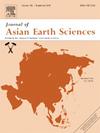Middle to Late Mississippian and Early Pennsylvanian foraminifers from the Dianzishang section, South China: Constraints on the Visean-Serpukhovian boundary and implications for biostratigraphic correlation across the Paleo-Tethys Ocean
IF 2.7
3区 地球科学
Q2 GEOSCIENCES, MULTIDISCIPLINARY
引用次数: 0
Abstract
A high-resolution, integrative stratigraphic framework is critical for better understanding of the co-evolution of marine biodiversity and paleo-environments during the middle Mississippian to early Pennsylvanian. There are, however, inconsistencies regarding the use of conodonts as index fossils for the stratigraphic correlation of this period, partly due to their facies-dependent occurrence. Foraminifera, widely present in both shallow-water carbonate platforms and deep-water slope sequences, offer a more globally applicable tool as auxiliary index fossil. In this study, we present a high-resolution foraminiferal biostratigraphy from the Dianzishang carbonate slope succession in the South China Block. The foraminifers can be identified into four zones: the Paraarchaediscus koktjubensis Zone, Bradyina modica Zone, Globivalvulina moderata Zone, and Postmonotaxinoides Zone, which are correlated with zonations of Iran, the East Europe Platform, and West Europe. The combined foraminiferal and conodont data in the Dianzishang section suggest the FOD of Lochriea ziegleri here is likely younger than the base of the Serpukhovian and the presence of a stratigraphic hiatus around the Visean-Serpukhovian boundary.
滇子上剖面中-晚密西西比世和早宾夕法尼亚世有孔虫:古特提斯洋visan - serpukhovian界线的约束及其生物地层对比意义
一个高分辨率的综合地层格架对于更好地理解密西西比世中期到宾夕法尼亚世早期海洋生物多样性和古环境的共同进化至关重要。然而,在使用牙形刺作为该时期地层对比的指示化石方面,存在不一致的地方,部分原因是牙形刺的产状依赖于相。有孔虫广泛存在于浅水碳酸盐岩台地和深水斜坡层序中,是一种全球适用的辅助指示化石。本文对华南地块电子上碳酸盐岩坡系进行了高分辨率有孔虫生物地层学研究。有孔虫可划分为4个带:Paraarchaediscus koktjubensis带、Bradyina modica带、Globivalvulina moderata带和Postmonotaxinoides带,它们与伊朗、东欧地台和西欧的带相对应。电子上剖面的有孔虫和牙形石综合资料表明,Lochriea ziegleri的FOD可能比Serpukhovian基底更年轻,并且在visan -Serpukhovian边界附近存在地层裂孔。
本文章由计算机程序翻译,如有差异,请以英文原文为准。
求助全文
约1分钟内获得全文
求助全文
来源期刊

Journal of Asian Earth Sciences
地学-地球科学综合
CiteScore
5.90
自引率
10.00%
发文量
324
审稿时长
71 days
期刊介绍:
Journal of Asian Earth Sciences has an open access mirror journal Journal of Asian Earth Sciences: X, sharing the same aims and scope, editorial team, submission system and rigorous peer review.
The Journal of Asian Earth Sciences is an international interdisciplinary journal devoted to all aspects of research related to the solid Earth Sciences of Asia. The Journal publishes high quality, peer-reviewed scientific papers on the regional geology, tectonics, geochemistry and geophysics of Asia. It will be devoted primarily to research papers but short communications relating to new developments of broad interest, reviews and book reviews will also be included. Papers must have international appeal and should present work of more than local significance.
The scope includes deep processes of the Asian continent and its adjacent oceans; seismology and earthquakes; orogeny, magmatism, metamorphism and volcanism; growth, deformation and destruction of the Asian crust; crust-mantle interaction; evolution of life (early life, biostratigraphy, biogeography and mass-extinction); fluids, fluxes and reservoirs of mineral and energy resources; surface processes (weathering, erosion, transport and deposition of sediments) and resulting geomorphology; and the response of the Earth to global climate change as viewed within the Asian continent and surrounding oceans.
 求助内容:
求助内容: 应助结果提醒方式:
应助结果提醒方式:


